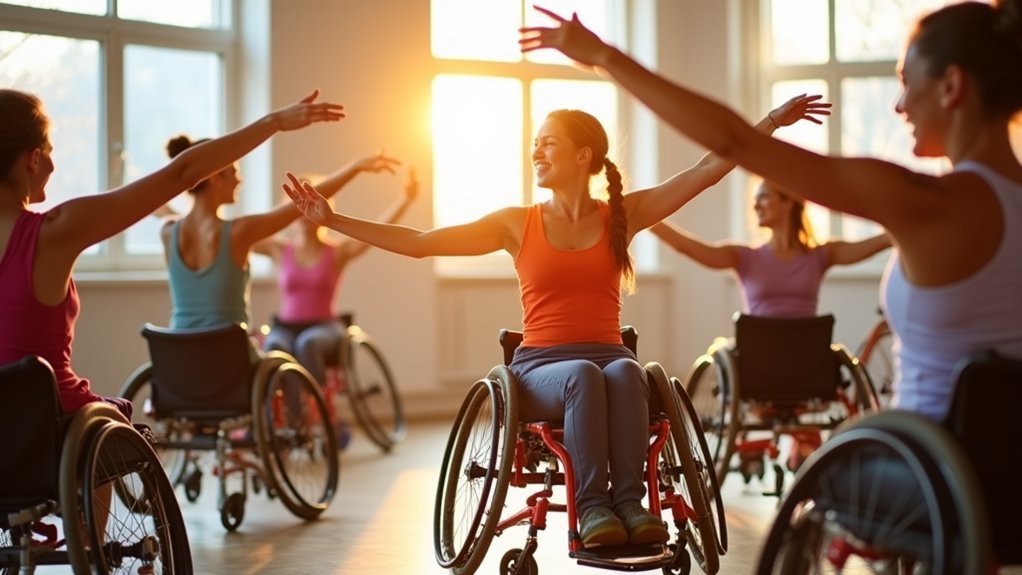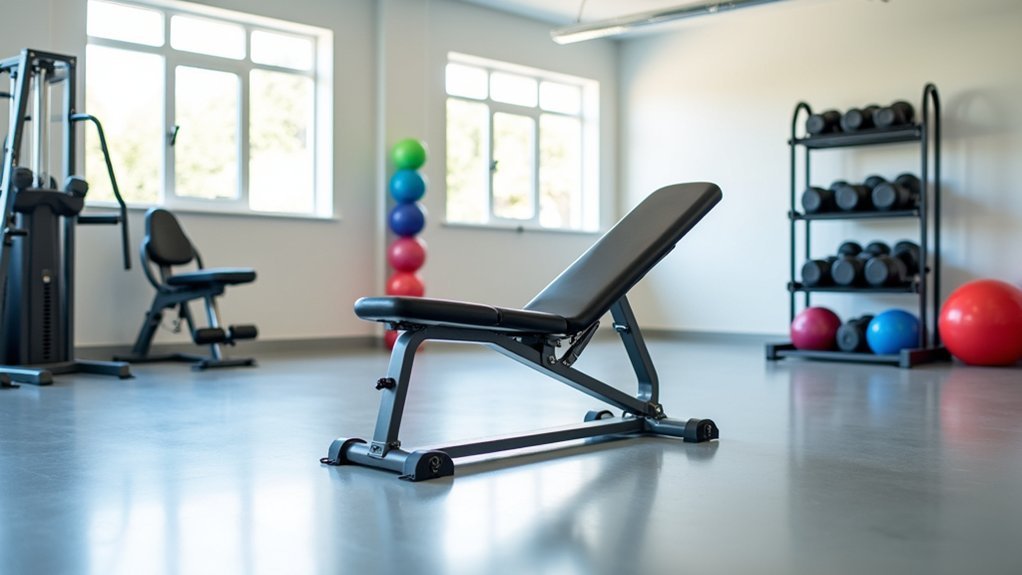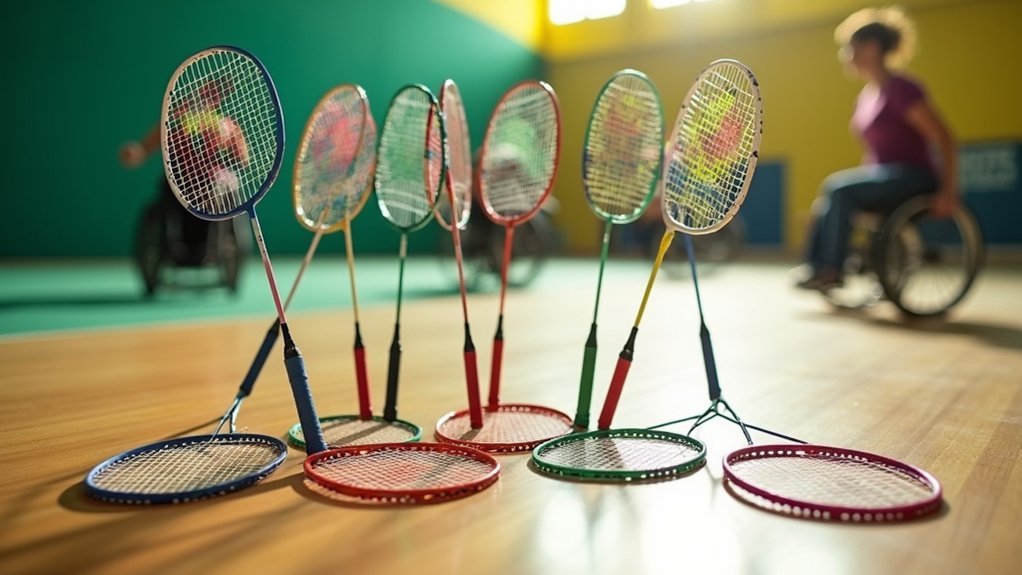Wheelchair dance accelerates stroke recovery by activating powerful mind-body connections that foster neuroplasticity. When you move rhythmically to music, you’re creating new neural pathways while simultaneously reducing stress and anxiety. This holistic approach integrates physical rehabilitation with emotional healing, shifting your focus from limitations to creative expression. You’ll build confidence, enhance coordination, and connect with others on similar journeys. The transformation extends beyond physical improvement into reclaiming your identity and narrative through movement.
The Mind-Body Connection in Post-Stroke Wheelchair Dance

When stroke survivors engage in wheelchair dance, they activate a powerful mind-body connection that transcends typical rehabilitation approaches.
You’ll notice how this recreational therapy heightens awareness of your movements and postures, creating neural pathways that help overcome physical limitations caused by stroke.
As you wheel and turn to music, you’re not just exercising—you’re rebuilding the critical communication between your brain and body.
This heightened awareness helps you reclaim control over movements that once seemed impossible.
Unlike conventional therapy, wheelchair dance demands your full attention to rhythm, space, and expression, fostering neuroplasticity and accelerating recovery.
The mind-body connection developed through wheelchair dance helps you translate newfound body awareness into daily activities, making this form of recreational therapy uniquely valuable for stroke survivors.
How Rhythmic Movement Rewires the Brain After Stroke
When you participate in wheelchair dance, your brain forms new neural pathways at remarkable speeds through consistent rhythmic movement.
Music’s structure amplifies your recovery by synchronizing physical movements with beat patterns, creating stronger connections between your motor cortex and muscles.
Your body and mind rebuild their relationship as dance activates multiple brain regions simultaneously, helping you regain control over movements that were once automatic before your stroke.
Neural Pathways Strengthen Fast
Although stroke damage can seem permanent, the brain possesses remarkable abilities to rebuild itself through a process called neuroplasticity.
When you engage in wheelchair dance, you’re activating this powerful mechanism, creating new neural connections that bypass damaged areas.
Your brain responds quickly to the rhythmic movements of dance, simultaneously engaging multiple brain regions. This cross-activation accelerates rehabilitation as your motor control centers form new pathways.
The structured patterns you follow during dance sessions specifically target areas responsible for coordination and movement, offering unique benefits for people recovering from stroke.
You’ll likely notice improvements in balance and walking abilities faster than with traditional therapy alone.
Plus, as you master new movements, you’re not just rewiring your brain—you’re rebuilding confidence essential for your recovery journey.
Music Amplifies Movement Recovery
Music acts as a powerful catalyst in stroke recovery, turbocharging the neuroplasticity benefits of wheelchair dance. When you move rhythmically to music, your brain forms new neural connections that help rebuild damaged pathways affected by stroke.
The auditory stimulation provided by music directly enhances your movement skills, improving balance and coordination that stroke often compromises. You’ll notice these improvements translate to daily activities, increasing your independence.
For people with disabilities, particularly stroke survivors, music-based therapies reduce stress and anxiety—emotional barriers that can hinder physical recovery.
The engaging nature of wheelchair dance with music creates a dual benefit: you’re simultaneously strengthening motor functions while boosting your psychological well-being.
This powerful combination of movement and melody creates an ideal environment for your brain’s healing process, accelerating your recovery journey.
Body-Mind Connection Rebuilds
Rebuilding the body-mind connection after stroke depends critically on rhythmic wheelchair dance, which triggers neuroplasticity in ways ordinary therapy can’t match. As you move to music, your brain forms new neural pathways, effectively rewiring itself to compensate for damaged areas.
The benefits extend beyond physical rehabilitation. When you engage in wheelchair dance, you’re strengthening your lower back while simultaneously developing coordination and balance—skills that translate directly to daily independence.
People who participate in dance therapy consistently report higher confidence levels alongside improved movement skills.
This mind-body integration allows you to reconnect with your physical self. You’ll experience enhanced body awareness through deliberate movements and postures, creating a positive feedback loop where emotional expression through dance supports your mental health throughout recovery, accelerating your journey back to wellness.
From Patient to Performer: Transformative Power of Dance Therapy
When you join dance therapy as a stroke survivor, you’re not just moving your body—you’re rebuilding your sense of self through the mind-body healing connection.
Your transformation from patient to performer allows you to reclaim your identity through movement, shifting focus from limitations to creative expression.
Dance therapy offers customized recovery pathways that adapt to your unique abilities, ensuring everyone can participate regardless of mobility challenges.
Mind-Body Healing Connection
Although traditional rehabilitation focuses on separate therapies, dance therapy represents a revolutionary integration of speech, physical, and occupational approaches that transforms stroke survivors from patients to performers.
When you participate in Wheelchair Dance, you’re not just moving your body—you’re rewiring your brain.
The great benefits extend beyond physical improvement. As you express emotions through movement, you’ll experience neuroplastic changes that enhance balance and coordination while reducing depression and isolation.
You’ll feel more like a dance student than a patient, building confidence and community connections that fuel your recovery journey. This mind-body connection nurtures both your physical rehabilitation and emotional wellbeing, creating a holistic healing experience that traditional therapies alone can’t provide.
Reclaiming Identity Through Movement
Many stroke survivors experience a profound loss of identity when their physical abilities change. Wheelchair dance therapy transforms this narrative by helping you shift from patient to performer. When you engage in dance, you’re not defined by your limitations but by your creative expression.
The transformative journey includes:
- Psychological shift – You’ll experience joy and empowerment as dance becomes your vehicle for self-expression.
- Neurological benefits – Your brain forms new pathways through movement, enhancing physical abilities while building confidence.
- Social reconnection – As you perform, you’ll break isolation barriers and forge meaningful connections.
Through movement, you reclaim control of your narrative. Dance therapy creates space for emotional expression, helping you rebuild your identity and rediscover yourself beyond the stroke experience.
Customized Recovery Pathways
The journey from patient to performer begins with a personalized approach to wheelchair dance therapy. When you engage in structured dance programs like the Wheelchair Abilities Dance Program, you’re not just following a generic protocol—you’re participating in a tailored recovery experience that addresses your specific needs.
Dr. Patterson’s research confirms that your rehabilitation benefits extend beyond physical improvements to include enhanced confidence and quality of life.
Julie Tomaino’s shift from stroke patient to dance teacher exemplifies how you can actively shape your recovery journey. Rather than remaining passive recipients of care, you’ll become an expressive participant in your healing.
Programs like Momenta create environments where you’re seen as a dancer first, not a patient, allowing you to rebuild your identity through movement while strengthening community connections.
Building Confidence Through Wheelchair Choreography
Transforming a rehabilitation process into an artistic journey, wheelchair choreography offers stroke survivors a powerful pathway to rebuild confidence and self-esteem.
You’ll discover that dance isn’t just movement—it’s a form of expression that shifts your identity from patient to performer, fundamentally changing how you see yourself during recovery.
When you join a wheelchair dance program, you’ll experience:
- A supportive community that celebrates achievements together, diminishing feelings of isolation
- Enhanced physical capabilities through improved coordination and balance in a creative context
- Emotional release through artistic expression, leading to improved mental health and motivation
This therapeutic approach helps you view yourself through a new lens—as a dancer with unique abilities rather than focusing on limitations.
Social Benefits of Group Dance for Stroke Survivors

Beyond individual growth, wheelchair dance cultivates a powerful social ecosystem for stroke survivors.
You’ll find yourself breaking free from the isolation that often follows stroke recovery as you connect with others who understand your journey.
In these supportive communities, you’re not just moving together—you’re building meaningful relationships that fuel your rehabilitation motivation.
When you see a fellow dancer achieve a new movement, it inspires your own recovery goals.
Dance sessions become platforms for communication and self-expression, helping you rediscover ways to connect with others beyond words.
The shared experience of creating something beautiful together fosters emotional well-being and brings joy to what can otherwise be a challenging recovery process.
You’ll leave each session feeling uplifted and socially recharged.
Physical Rehabilitation Outcomes of Wheelchair Dance Programs
While many traditional therapies focus solely on repetitive exercises, wheelchair dance programs deliver measurable physical benefits through joyful, engaging movement.
You’ll experience neuroplastic changes in your brain as you dance, rewiring neural pathways damaged by stroke and accelerating your recovery journey.
Three key physical improvements you’ll notice:
- Enhanced balance and coordination that transfers directly to daily activities
- Increased strength and endurance that builds gradually through consistent participation
- Better movement retention, as dance engages multiple brain regions simultaneously
You’re more likely to stick with wheelchair dance than conventional therapy because it’s enjoyable.
This higher participation rate directly impacts your recovery success, helping you regain independence faster while feeling motivated rather than frustrated by the rehabilitation process.
Customizing Dance Movements for Different Recovery Stages

Adapting wheelchair dance for early recovery means you’ll start with gentle upper body movements while maintaining proper posture and support.
You can incorporate rhythmic hand gestures, shoulder rotations, and facial expressions that build confidence without overwhelming physical capabilities.
As your recovery progresses, you’ll gradually introduce more complex movements, including coordinated arm-torso integration and eventually partner work that challenges balance and spatial awareness.
Early Recovery Adaptations
Since stroke recovery follows a distinct progression, wheelchair dance instructors must tailor movements to match each patient’s current abilities and limitations.
In the earliest stages, gentle movements maintain engagement without overwhelming your still-healing body.
During initial sessions, you’ll experience:
- Gentle rhythmic exercises that accommodate limited mobility while strengthening specific muscle groups affected by your stroke
- Music-enhanced movements that boost your emotional wellbeing and motivation during what can be a challenging recovery period
- Progressive complexity that evolves with your improving capabilities, introducing more intricate patterns as you regain function
These carefully designed adaptations harness the power of rhythm and repetition, reinforcing essential motor skills and cognitive functions.
Your dance therapy creates a foundation that supports both physical and emotional aspects of recovery.
Progressive Movement Techniques
Three distinct phases characterize the progressive movement approach in wheelchair dance for stroke recovery. You’ll experience customized movements that align with your specific recovery stage, ensuring you’re challenged appropriately without overexertion.
| Phase | Focus | Benefits | Timeline |
|---|---|---|---|
| Foundation | Basic coordination & range | Builds confidence, establishes neural pathways | Weeks 1-4 |
| Development | Increased complexity & flow | Enhances balance, strengthens core muscles | Weeks 5-12 |
| Refinement | Integrated movements & expression | Improves independence, fine motor control | Months 3-6+ |
As you progress, each movement incorporates therapeutic exercises that promote neuroplasticity. Real-time feedback during sessions helps you understand your physical boundaries while gradually increasing complexity. This structured approach doesn’t just rebuild strength—it transforms rehabilitation into an engaging journey where you’ll see measurable improvements in coordination, balance, and independence.
Success Stories: Real-Life Transformations Through Dance
Behind every statistic in wheelchair dance therapy lies a personal journey of triumph and transformation.
Julie Tomaino’s return to teaching dance after her stroke and Robby Williams’ adaptation through the Momenta program showcase the profound impact of dance on recovery.
Dr. Patterson’s research confirms what these success stories demonstrate—wheelchair dance creates meaningful changes in survivors’ lives:
- Physical improvements in balance and walking skills that traditional therapy alone mightn’t achieve
- Enhanced quality of life with reduced social isolation through supportive dance communities
- Neuroplastic brain changes that accelerate recovery through joyful, engaging movement
You’ll find inspiration in these stories as they reveal how dance therapy doesn’t just rehabilitate bodies—it restores confidence, joy, and purpose after stroke.
The Role of Music in Enhancing Movement Recovery
When rhythm meets rehabilitation, something remarkable happens in the brain of stroke survivors. Music creates neural pathways that improve your balance, gait, speech, memory, and focus—organizing motor movements when muscle control is compromised.
Music rewires the stroke-affected brain, creating pathways that reconnect movement when traditional control systems fail.
You’ll find singing familiar songs during therapy particularly effective; these melodies often flow more naturally than speech alone. The rhythmic qualities of music trigger spontaneous movement without the overthinking that can hinder progress.
Instead of battling elevated stress and anxiety, you’ll experience improved emotional well-being through music therapy, creating an ideal environment for healing. Incorporating various musical instruments, especially digital ones, provides diverse stimuli that enhance your therapy’s effectiveness.
Music doesn’t just accompany your wheelchair dance journey—it fundamentally transforms how your brain and body reconnect during recovery.
Overcoming Physical Limitations Through Creative Expression
Wheelchair dance transforms physical limitations into opportunities for artistic discovery and healing. When you engage in adaptive dance, your brain forms new neural pathways that help bypass damaged areas, effectively retraining your body to move in different ways.
You’re not just exercising—you’re creating art while rebuilding critical movement capabilities.
Here’s how creative expression through wheelchair dance helps:
- Enhances coordination and posture – Every choreographed movement contributes to your physical recovery.
- Builds confidence and independence – As you master new movements, you’ll gain skills that transfer to daily activities.
- Fosters community connection – You’ll identify as a dancer rather than a patient, reducing isolation and improving emotional well-being.
Integrating Dance Into Traditional Rehabilitation Protocols
Although traditional stroke rehabilitation focuses primarily on isolated physical exercises, integrating dance therapy creates a more engaging and thorough recovery experience.
When you participate in dance therapy, you’re simultaneously addressing multiple rehabilitation goals—combining speech, physical, and occupational therapy in one holistic approach.
Research confirms that dance promotes neuroplastic changes in your brain, enhancing recovery outcomes beyond what conventional therapies alone might achieve.
Dance activates your brain’s healing potential, creating neural pathways that traditional therapies simply cannot match.
You’ll notice significant improvements in balance and movement skills, vital elements for regaining independence.
Perhaps most transformative is how dance therapy shifts your identity from patient to creator.
You’re no longer just receiving treatment—you’re actively learning and expressing yourself.
This change in perspective reduces feelings of isolation while building confidence, turning rehabilitation from a clinical process into a meaningful journey of self-discovery.
Finding Joy in Movement: The Emotional Healing Effects
Beyond physical rehabilitation, the emotional healing effects of wheelchair dance often create profound transformations in stroke survivors’ recovery journeys.
When you participate in wheelchair dance, you’ll experience a natural boost in endorphins that reduces stress and elevates your mood—essential components for psychological healing.
The emotional benefits you’ll gain include:
- Enhanced self-acceptance – You’ll develop a renewed relationship with your body, embracing its capabilities rather than focusing on limitations.
- Reduced isolation – You’ll build meaningful connections with others in a supportive, inclusive environment.
- Creative expression – You’ll find new ways to communicate your experiences and emotions without words.
This emotional healing complements physical progress, creating a holistic approach to recovery that addresses your complete well-being.
Frequently Asked Questions
Is Dancing Good After a Stroke?
Yes, dancing is good after a stroke. You’ll benefit from its neuroplastic effects, improved movement skills, better balance, and reduced isolation. It’s an empowering activity that boosts your confidence and enhances your recovery journey.
How Do You Motivate a Stroke Recovery?
To motivate stroke recovery, set achievable goals that give you purpose. Celebrate small improvements, engage in enjoyable activities like dancing, join support groups for social connection, and surround yourself with positive encouragement from others.
What Is the Best Exercise for Stroke Patients?
Wheelchair dance is your best exercise choice for stroke recovery. It improves neuroplasticity, burns calories, enhances coordination, and boosts emotional well-being. You’ll regain mobility faster while enjoying social connections through this engaging therapy.
How Do You Help a Stroke Victim Regain Movement?
You’ll help stroke victims regain movement through consistent physical therapy, dance activities, and repetitive exercises. Encourage daily practice, celebrate small wins, and maintain a positive environment that promotes neuroplasticity and confidence.
In Summary
When you embrace wheelchair dance as part of your stroke recovery, you’re not just moving your body—you’re rebuilding neural pathways, regaining confidence, and reconnecting with joy. Don’t underestimate how rhythm and creative expression can accelerate healing beyond traditional therapy alone. By joining this supportive community, you’ll transform from patient to performer, finding freedom in movement despite physical limitations. Your recovery journey becomes a dance itself.





Leave a Reply